Keeping a fish tank in your home brings many benefits to your health, such as lowering stress and reducing blood pressure. And a small freshwater aquarium would be a better choice as it’s easier to maintain. Small tanks will save you money and space in your home.
In this post, we’ll introduce some of the best fish for small tanks. All of them are equal or less than 3 inches, making a great addition to your tiny aquarium.
A List of Best Fish for Small Tanks
1. Betta Fish

- Size: 3 inches
- Minimum tank size: 5-10 gallons
Betta fish (Siamese fighting fish) is a small tropical species that comes from the tropical waters of Southeast Asia. These tropical fish are famous for being violently territorial.
There are more than 73 varieties of the genus betta, and they are some of the most widely available tank fish in the world. This boils down to their range of vivid colours, large flowing fins and intelligence.
You will want to give this fish a stimulating environment. A 5-gallon planted tank with numerous decorations to keep the fish stay active and healthy.
Learn more: 10 Best Betta Fish Tanks (Reviewed + Buying Guide)
2. Scarlet Badis
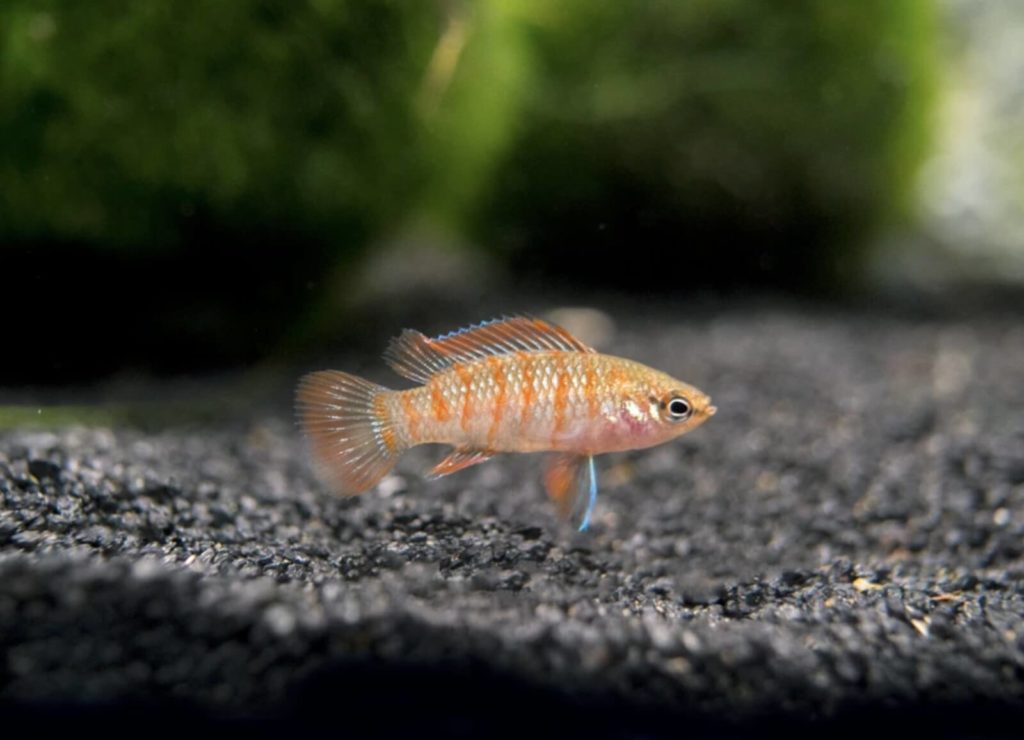
- Size: 0.8 inches
- Minimum tank size: 10 gallons tanks
The main color of Scarlet Badis is red or orange. Usually, there is a lighter shade with vertical stripes of a darker one.
Mostly, the fish are peaceful and non-aggressive. However, they are considered micro predators. That means they will search for insect larvae, tiny crustaceans and any source of protein they can look for.
You can keep the fish happy with a high-protein diet with frozen and live food.
Due to their predatory behavior towards smaller tank mates, you should not house them with shrimp. Despite their small size, Scarlet Badis can easily hunt and consume ornamental shrimp in your tank.
3. Neon Tetra
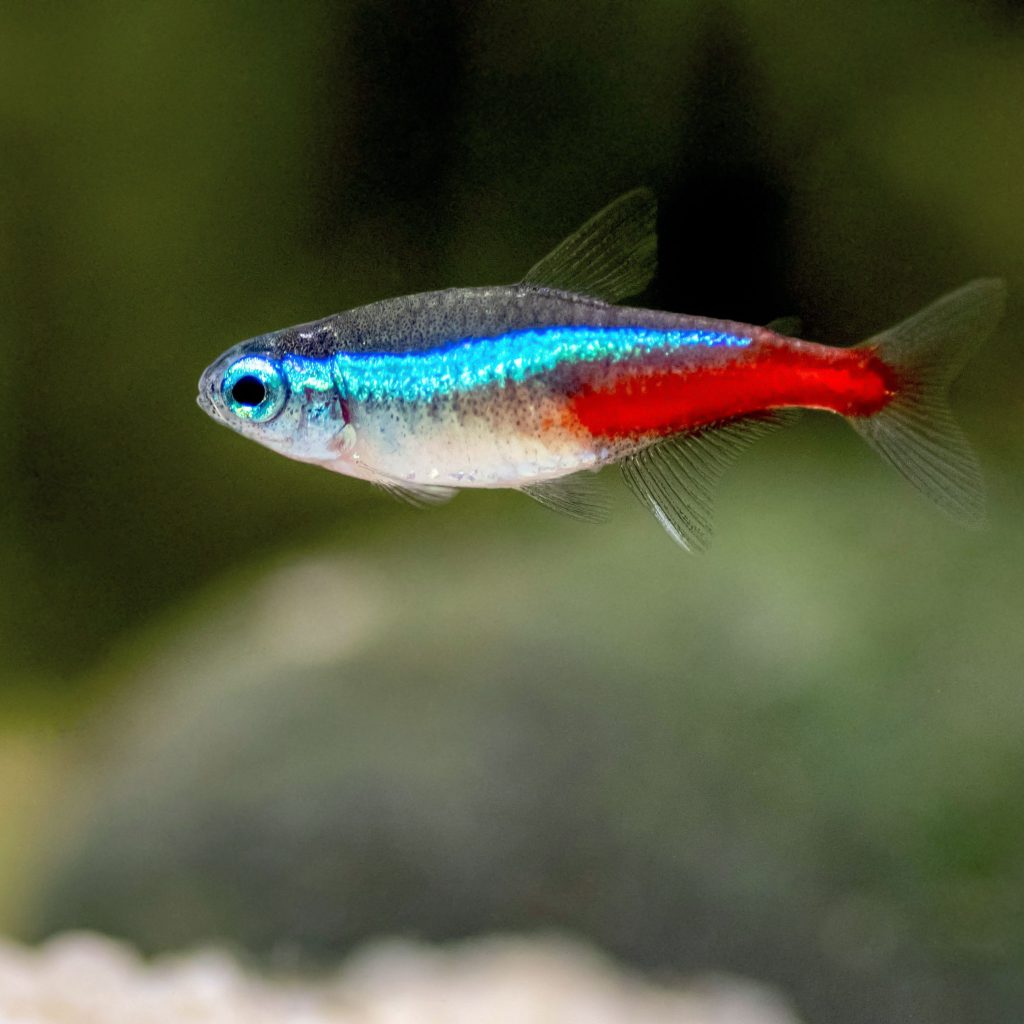
- Size: 1.5 inches
- Minimum tank size: 10-20 gallons
These pint-sized fish are widely-seen around the world and can live happily in both small and large tanks.
The fish is named after its coloration. Neon Tetra has bold stripes of vibrant red and blue throughout its body. Males are likely more vivid than females.
Playful by nature, the fish are such a joy to watch. They perform best in larger schools of fish. As they grow up, they’ll generate a swath of color that moves amazingly throughout your aquarium.
Most significantly, they are simple to care for. These species are unfussy and quite hardy, preferring a temperature of 70-81 degrees Fahrenheit and a pH balance of 7.0 or less.
Read more: Pregnant Neon Tetras: Is Your Fish is Ready to Reproduce?
4. Cardinal Tetra

- Size: 2 inches
- Minimum size: 15 gallons tank
Although having a similar appearance to Neon Tetra, Cardinal Tetra is a different species with its own care requirements. While they share the same red and blue coloration, some small differences in shape and pattern make it simple to distinguish the two species.
Originally coming from South America, these nano tank fish prefer to bring kept in large groups. They do best in environments covered with organic hiding spots. Floating plants, rock caves, and driftwood are all great.
The fish love warmer waters, between 73-82 degrees Fahrenheit. The proper pH level for Cardinal Tetra is as low as 4.6.
5. Fancy Guppies

- Size: 2 inches
- Minimum size: 5 gallons tank
Guppies are also suitable fish for small tanks, which feature a visually brilliant appearance. The fish have long and flowing tails. Their caudal fins fan out a bit, generating a flash of color in your aquarium.
Like Betta Fish, Guppies are available in plenty of colors and patterns. You can find solid-colored specimens in bright colors like orange, red and blue. However, most of them tend to have some type of stripping or spotted pattern.
They are peaceful creatures that prefer staying toward the top of the water column. They are not aggressive, but their tempting colors might make them a target for predators.
Notably, Fancy Guppies can breed without any intervention. Simply provide the right water conditions and a safe place for them to spawn. The fish are livebearers, so the fry will grow inside the female. When they are born, they come out as completely formed baby creatures.
6. Chili Rasbora

- Size: 0.7 inches
- Minimum tank size: 5-10 gallons
Also called Mosquito Rasbora, Chili Rasbora is a colorful fish for small tanks. These creatures are covered in shades of pink and red, making them stick out in the tank. Usually, the base color is complemented by a contrasting black stripe.
Despite their eye-catching looks, the fish seem to be timid. As they’re brought to a new environment, they tend to spend most of their time hiding. This behavior gradually disappears when they feel more comfortable.
The best way to make your Chili Rasbora confident in their tank is to house them in a group. These schooling fish love spending their days together. They will often swim in one fluid motion, performing a mesmerizing show for any viewers.
Fishkeepers can feed Chili Rasboras with commercial dried food as their primary diet staple. However, in the wild, they are micro predators who love eating daphnia, brine shrimp, and tubifex micro worms.
7. Apistogramma

- Size: 3 inches
- Minimum tank size: 20-30 gallons
Apistogrammas are friendly fish for small tanks, getting along with most non-aggressive mates. They perform well in schools and can cohabitate environments with fish that take over the upper part of the aquarium. They often spend most of the time close to the substrate.
When it comes to appearance, these fish are absolute stunners with lots of color variations. You might find some fish covered in shades of yellow, red, or blue. Or you might find specimens with mohawk-like dorsal fins.
Impressively, there are more than 90 different varieties of Apistogramma. That means you have a lot of options to choose from.
8. Zebra Danio
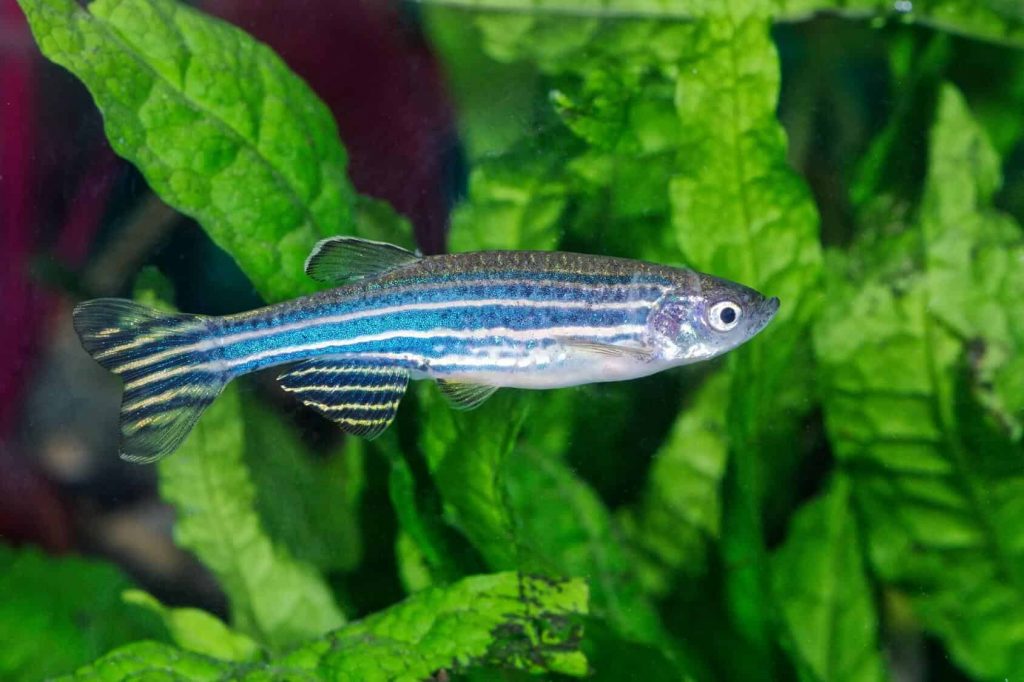
- Size: 2.5 inches
- Minimum tank size: 15 gallons
Zebra Danio is a colorful freshwater fish for small tanks, which is covered in black and white stripes. The stripes run horizontally, generating a cool effect as they’re dashing throughout the aquarium.
They’re known to live short lives when being alone, so you need to house them in large groups. These social fish love shoaling and swimming together.
The fish features a unique social hierarchy. Some fish will assert dominance over others to maintain the pecking order. However, this behavior is mostly playful and scarcely results in injury.
Zebra Danios likely stay in the middle of the water column. However, they might become hyperactive and occupy the whole tank if raised in very large groups.
9. White Cloud Mountain Minnow
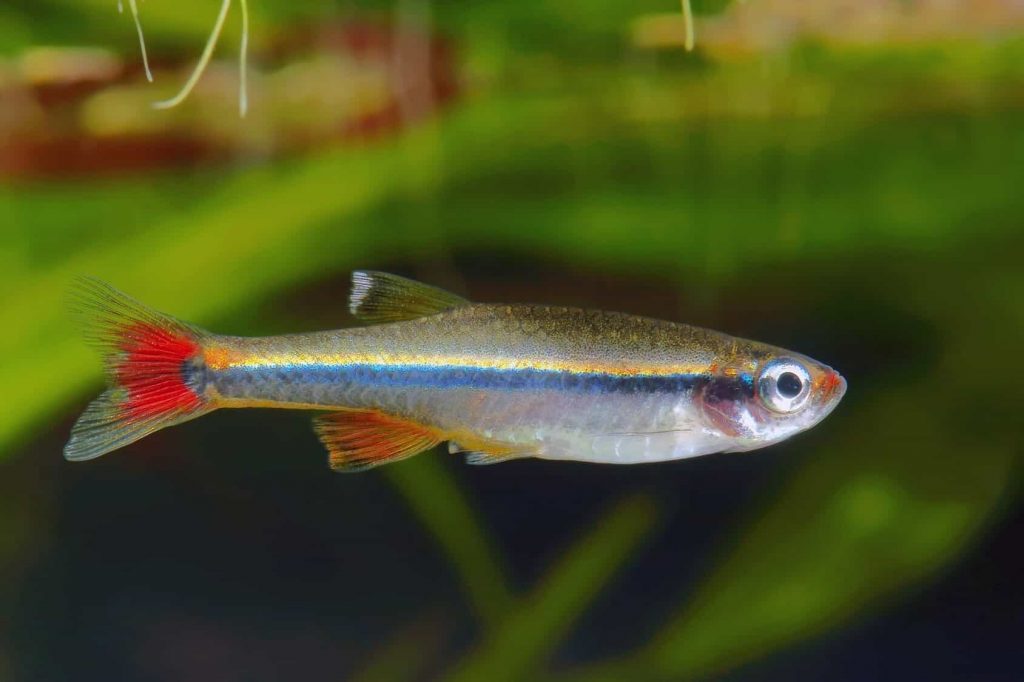
- Size: 2 inches
- Minimum tank size: 10 gallons
White Cloud Mountain Minnow are native to mountainous areas of Vietnam and China. They are a popular nano fish for small tanks.
These fish do look similar to Neon Tetras. They contain a prominent bright-blue strike spreading horizontally along the body. However, they don’t have the defined red stripe as Tetra. Instead, the red coloration is run throughout the fins and tail.
These fish are not demanding at all, which is a suitable choice for beginners. However, they do need some specific water parameters to stay happy. The fish prefer cooler water at about 60 degrees Fahrenheit and a pH between 6.0 and 8.0.
These species do best in schools of at least six as they’re social and playful.
10. Celestial Pearl Danio

- Size: 1 inch
- Minimum tank size: 10 gallons
Easy to maintain, Celestial Pearl Danio is another fish for small tanks. In the wild, the fish inhabit shallow rivers and ponds that are covered with plants.
These creatures love dense vegetation and warm water. The ideal temperature ranges from 73 to 79 degrees Fahrenheit.
Like other Danios, Celestial Pearls feature rounded bodies and large beady eyes. They have their name from the galaxy-like pattern on the body. The main color of the fish is black, but that’s broken up with some tiny white spots. You may also find some red coloration around the fins and belly. Some specimens even contain striped fins.
11. Sparkling Gourami

- Size: 1.5 inches
- Minimum tank size: 15 gallons
Here’s another suitable fish for small tanks that you can consider. Sparkling Gouramis look similar to a shell floating through the water. Their body is filled with beautiful pattern.
As usual, males will have patches of bright red and brown. This is combined with a series of bright blue dots that create an iridescent shimmer.
These fish are very friendly by nature. They are not looking for trouble and will be comfortable enough discovering the aquarium. These creatures tend to swim to the surface of the water to absorb some air, which is a quirky behavior.
12. Asian Stone Catfish
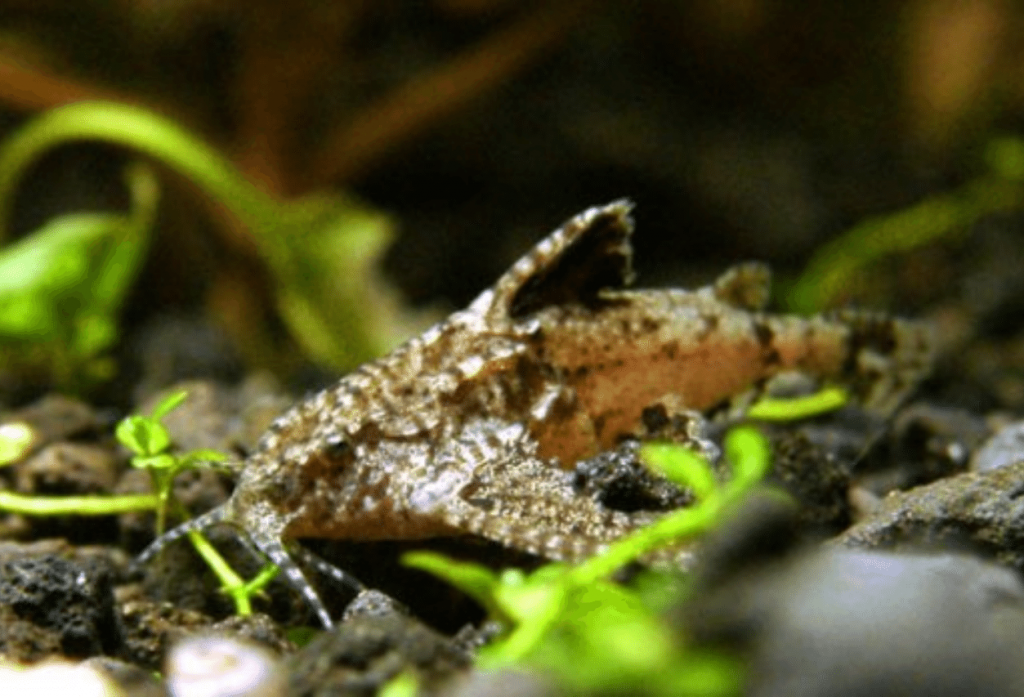
- Size: 1.5 inches
- Minimum tank size: 10 gallons
Asian Stone Catfish are one of the smallest catfish types. They make a striking addition to small tanks and will live in harmony with the most peaceful fish.
The body of these fish is very special. They excel at disguising thanks to their neutral body coloration. Splotches of black, brown, and grey contribute to an impressive texturized look. They blend in very well among debris and rocks, so they get their name.
Not demanding, these catfish can live in standard home aquarium conditions. However, they do need good oxygenation to stay healthy, so you can consider installing an air bubbler.
The fish are nocturnal fish that spend most of the time hiding. When the lights are off, they will be active and forage for food. They can snack on algae but prefer eating live or frozen food.
13. Peacock Gudgeon
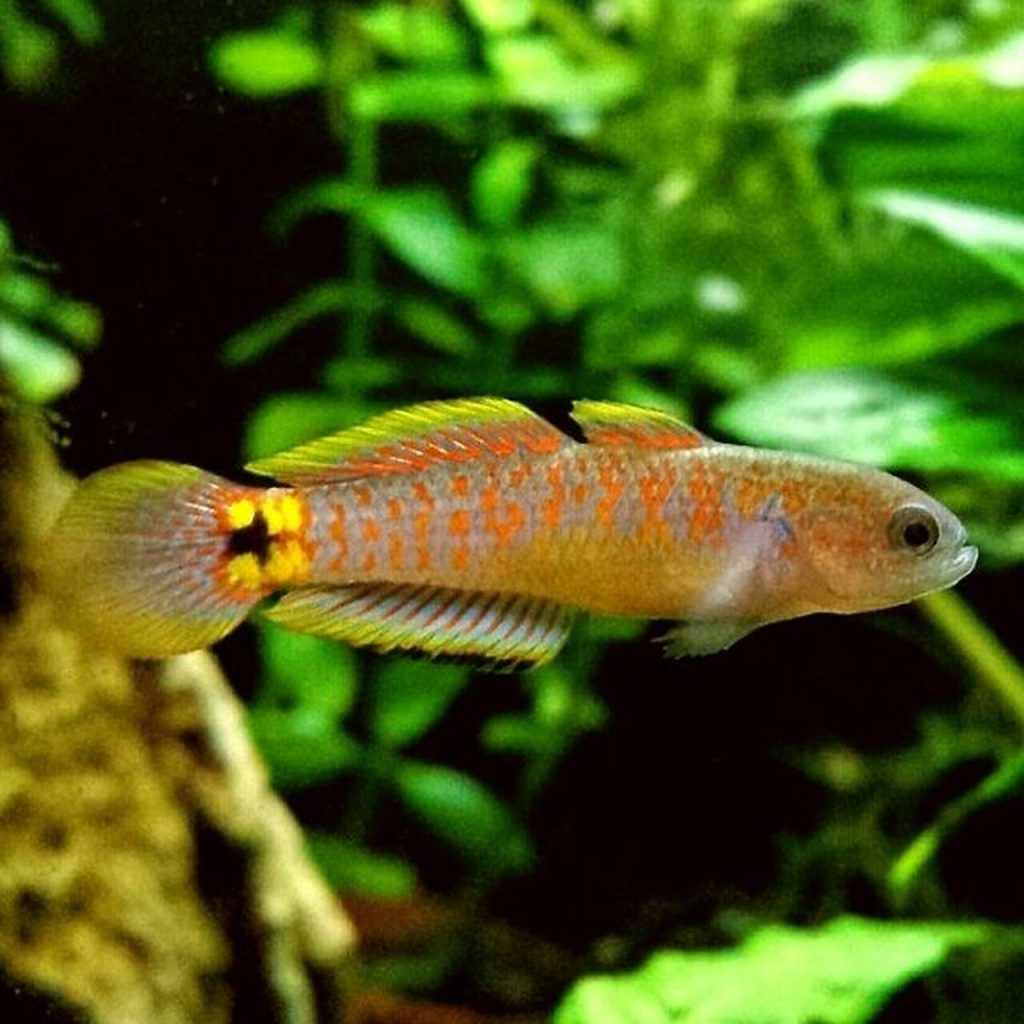
- Size: 3 inches
- Minimum tank size: 15 gallons
Peacock Gudgeons are ideal fish for small tanks, which are endemic to waters in Papua New Guinea, Australia, and New Zealand.
The fish feature slender bodies and rounded heads. The dorsal and anal fin is elongated, generating an interesting silhouette that sticks out.
The coloration of these creatures varies, but most have an iridescent blue base color that’s covered in bright red stripes. They feature a prominent black spot on the tale. Against the shape of their caudal fins, it looks similar to a peacock’s features.
Peacock Gudgeon prefers eating live or frozen food, and protein-rich food such as bloodworms and brine shrimp.
14. Otocinclus

- Size: 2 inches
- Minimum tank size: 10 gallons
Otocinclus are nano catfish bottom-dwellers that can consume a huge amount of algae in your tank.
Otos are cute fish for small tanks that bring a lot of entertainment.
Their look is featured by their armour-plated body and suckermouths. Otocinclus will remain small, reaching up to 2 inches in length.
It’s best to keep them in groups of at least 5 in a 10-gallon planted tank. However, in the wild, they are found in bigger shoals of thousands. The larger the tank is, the more active your fish will be.
15. Pygmy Corydoras
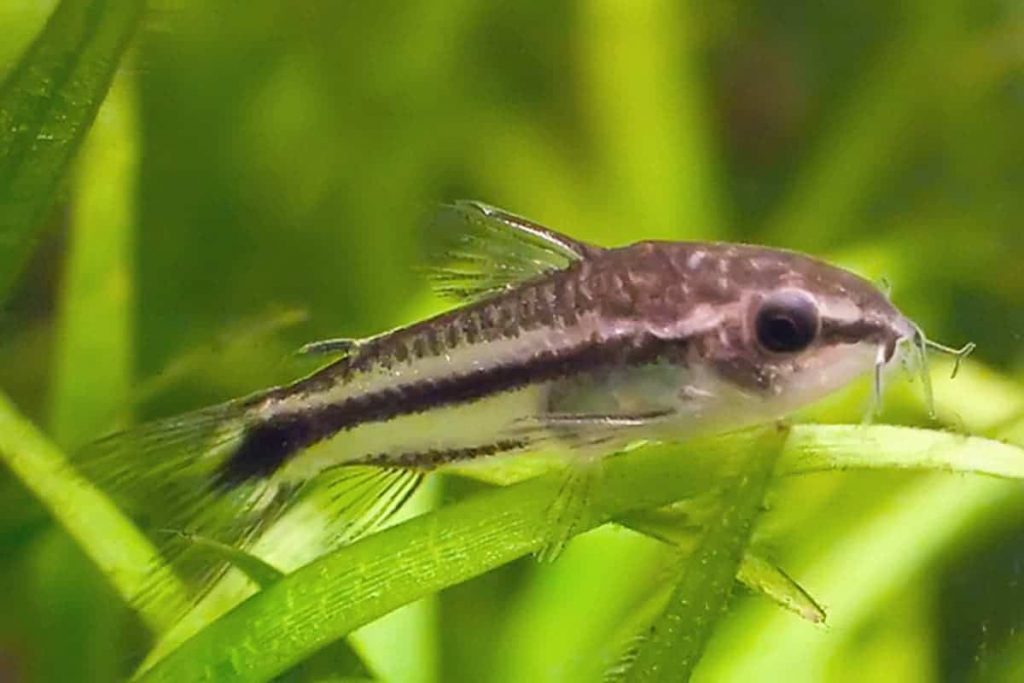
- Size: 1.3 inches
- Minimum tank size: 10 gallons
Pygmy corys are lovely tiny catfish for small tanks as they only reach up to 1.3 inches. They are active bottom swimmers that feature a slightly humped back. Their foreheads are sloped up to the hump at their dorsal fin. From there, their body tapers down toward the tail.
You should house them in groups of at least 5 in a 10-gallon planted aquarium. Moreover, these peaceful fish can get along with other smaller fish species in a community tank. You can feed them with algae wafers, sinking pellets, and frozen bloodworms.
Which Fish Will Be Your Next Member of Your Tank?
Now that you know a list of freshwater fish for small tanks. When deciding on which fish fits your aquarium, it’s critical to factor in the requirements of the fish you want to raise. Your best bet is to tailor your aquarium around the species.
Bear in mind that larger tanks are actually easier to take care of in a long time. Besides, they provide you with more space for fish and plants.
It’s obvious to see why small tanks have become a trend. They’re spectacular but compact enough to fit lots of different living situations and budgets.
There are so many interesting and creative things that can be done with these small tanks; the only limit is your imagination.





